

BBC News - Deep-sea mining 'must responsibly respect ecosystems' 17 February 2014Last updated at 11:12 By Jonathan Amos Science correspondent, BBC News, Chicago Elements such as lanthanum are in high demand for use in hybrid car batteries Scientists have made an impassioned plea for humanity to pause and think before making a headlong rush to exploit the deep sea.
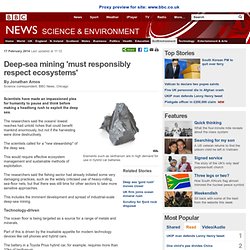
The researchers said the oceans' lowest reaches had untold riches that could benefit mankind enormously, but not if the harvesting were done destructively. One-fifth of all known hydrothermal vents are threatened by deep-sea mining. Tube worms and anemones on the Galapagos Rift. Photo Credit: NOAA Ocean Explorer. Seabed mining could earn Cook Islands 'tens of billions of dollars' Lockheed Martin · UK Government sponsors Lockheed Martin UK subsidiary for licence to harvest Polymetallic Nodules.
LONDON, UK, March 14, 2013 - UK Seabed Resources, a wholly owned subsidiary of Lockheed Martin UK, in partnership with the Department for Business Innovation and Skills, has received a licence and contract to explore a 58,000 sq kilometre area of the Pacific for mineral-rich polymetallic nodules.
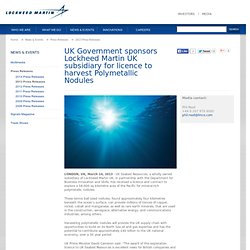
These tennis ball sized nodules, found approximately four kilometres beneath the ocean’s surface, can provide millions of tonnes of copper, nickel, cobalt and manganese, as well as rare earth minerals, that are used in the construction, aerospace, alternative energy, and communications industries, among others. Harvesting polymetallic nodules will provide the UK supply chain with opportunities to build on its North Sea oil and gas expertise and has the potential to contribute approximately £40 billion to the UK national economy, over a 30 year period. Lazurit CDB OJSCo. - Subsea Drilling System. The SUBSEA DRILLING SYSTEM is designed for deep offshore oil and gas development in the Russian Arctic and ensures year-round drilling irrespective of climatic and ice conditions.
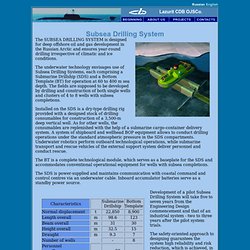
The underwater technology envisages use of Subsea Drilling Systems, each comprising a Submarine Drillship (SDS) and a Bottom Template (BT) for operation at 60 to 400 m sea depth. The fields are supposed to be developed by drilling and construction of both single wells and clusters of 4 to 8 wells with subsea completions. Installed on the SDS is a dry-type drilling rig provided with a designed stock of drilling consumables for construction of a 3,500-m deep vertical well. Vast Deposits of Gold and Other Ores Lure Seabed Miners. UK Seabed Resources joins deep-ocean mineral-mining rush. 14 March 2013Last updated at 03:13 ET.
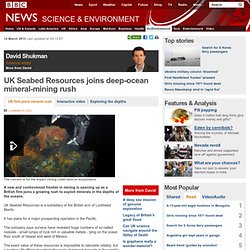
Deep sea miners to be shown ‘open door’ by UK. The Government wants an "open door" to deep sea miners looking for valuable minerals used in modern electronics, peers heard today.
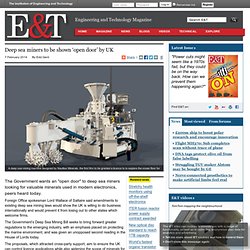
Foreign Office spokesman Lord Wallace of Saltaire said amendments to existing deep sea mining laws would show the UK is willing to do business internationally and would prevent it from losing out to other states which welcome firms. Deep Sea Mining Bill — Second Reading: 7 Feb 2014: House of Lords debates. Baroness Wilcox (Conservative) My Lords, some noble Lords will be aware of my keen interest in the sea as a native of Plymouth, with its rich maritime history.
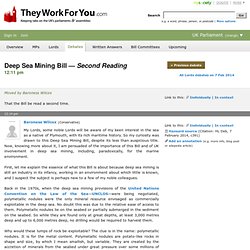
So my curiosity was drawn to this Deep Sea Mining Bill, despite its less than auspicious title. Now, knowing more about it, I am persuaded of the importance of this Bill and of UK involvement in deep sea mining, including, paradoxically, for the marine environment. First, let me explain the essence of what this Bill is about because deep sea mining is still an industry in its infancy, working in an environment about which little is known, and I suspect the subject is perhaps new to a few of my noble colleagues. Deep Sea Mining Bill (HL Bill 81)
China plans nuclear deep-sea mining base. A Chinese company is set to build a nuclear-powered mobile deep-sea station in the western Pacific, according to local reports.
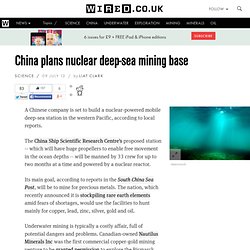
The China Ship Scientific Research Centre's proposed station -- which will have huge propellers to enable free movement in the ocean depths -- will be manned by 33 crew for up to two months at a time and powered by a nuclear reactor. Its main goal, according to reports in the South China Sea Post, will be to mine for precious metals.
The nation, which recently announced it is stockpiling rare earth elements amid fears of shortages, would use the facilities to hunt mainly for copper, lead, zinc, silver, gold and oil. Underwater mining is typically a costly affair, full of potential dangers and problems. Interactive video: Deep sea mining. 14 March 2013Last updated at 08:20 ET Companies are planning to extract minerals from areas of hydrothermal vents, deep on the seabed.
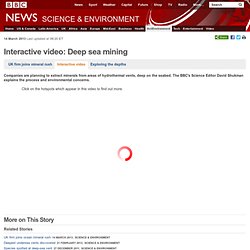
The BBC's Science Editor David Shukman explains the process and environmental concerns. Click on the hotspots which appear in this video to find out more. This interactive content is best viewed on the desktop site. X Hydrothermal vents are fissures on the seabed where water penetrates the Earth's crust and is heated to extreme temperatures by geological activity. Nautilus Minerals Inc. - Resource Extraction - Mon Mar 17, 2014. The Offshore Production System comprises three main components: Riser and Lifting System (RALS) The RALS comprises a large pump and rigid riser pipe hanging from a vessel which delivers the slurry to the surface.
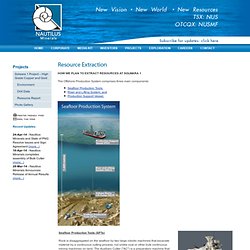
Nautilus Cares. Mining the Abyss. Pacific islanders have always been sustained by the ocean.
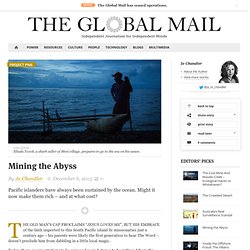
Might it now make them rich – and at what cost? The old man’s cap proclaims “Jesus Loves Me”, but his embrace of the faith imported to this South Pacific island by missionaries just a century ago – his parents were likely the first generation to hear The Word – doesn’t preclude him from dabbling in a little local magic. Today, there are incantations to be sung and sacred stones to be gathered from the enchanted forest enclosing his village; according to lore, this is a place of potent power. He checks off a list of ritual devotions that will ready his body, soul and canoe for a perilous expedition. At dawn he will push his outrigger into the Bismarck Sea, drop some stones in the water at his ples masalai (spirit place) and paddle to the horizon.
Eliuda Toxok is a shark caller. Nautilus Minerals still keen on Solwara I project - Business Advantage PNG. During a conference call last night, the interim President and Chief Executive Officer of Nautilus Minerals, Mike Johnston, said the Canadian company still intends to develop the Solwara I deep sea bed mine project, despite terminating its agreement with the PNG Government. Nautilus has announced the termination after the government failed to complete its purchase of 30% of the Solwara 1 Project, as ordered by an independent arbitrator last October.
The PNG Government signed an agreement in March 2011 to exercise its option to take a 30% shareholding in the world’s first sea bed mining project in the Bismarck Sea, off the north coast of Papua New Guinea. However, it failed to complete the purchase and, in June 2012, took Nautilus to compulsory arbitration. MINING AT DEEP-SEA VENTS: WHAT ARE THE IMPACTS ON MARINE LIFE? Deep-sea hydrothermal vents are one of the seafloor environments now being targeted for mining of their mineral resources, because the “chimneys” that form at vents are particularly rich in metals such as copper that we need for modern technology. But what are the possible impacts on marine life from mining at deep-sea vents? For the first of two blog posts to accompany Week 6 of our “Massive Open Online Course” on “Exploring our oceans”, I’ll attempt a summary here, because the impact of greatest concern on marine life is perhaps not the most obvious. And because it’s perhaps not obvious, this will be long article – starting with some key features of deep-sea vents, and what mining at vents will involve.
MINING AT DEEP-SEA VENTS: WHAT ARE THE IMPACTS ON MARINE LIFE? Mining seafloor massive sulphides and biodiversity: what is at risk? UK company pursues deep-sea bonanza. A bizarre episode from the cold war could foreshadow a new era of seabed mining. In 1974, the US government used a ship owned by eccentric billionaire Howard Hughes to pick up the remains of a Russian nuclear-missile-bearing submarine that sank in more than 5,000 metres of water. As cover, the United States claimed that the expedition was collecting polymetallic nodules: rocky lumps that litter the deep sea floor, rich in metals such as manganese, nickel, copper, cobalt and rare-earth elements. Polymetallic Nodules. Vast cache of rare earth elements found in Japan's mud - environment - 02 April 2013. Japan keeps finding treasure in deep-sea mud. Let's take better care of our rare earth elements - tech - 15 February 2011. Despite their name, rare earth elements are not especially rare.
So how come we are so worried about them running out? THE periodic table is a thing of beauty, yet we seem to be quite happy to exhaust parts of it before we've fully realised its potential. Helium will probably run out within the next 100 years. Gallium and indium are running low. ENG9.pdf.